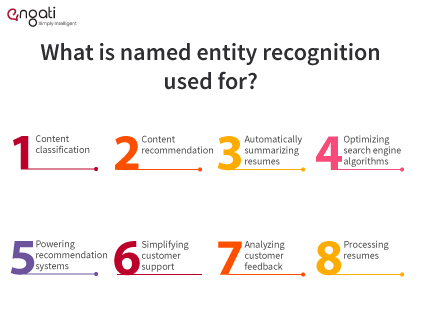What is named-entity recognition?
Named-entity recognition is a sub-task of information extraction that seeks to locate and classify named entities mentioned in unstructured text into predefined categories such as person names, organizations, locations, medical codes, time expressions, quantities, monetary values, percentages, etc.
To put it simply, NER deals with extracting the real-world entity from the text such as a person, an organization, or an event. Named Entity Recognition is also simply known as entity identification, entity chunking, and entity extraction. They are quite similar to POS(part-of-speech) tags.
%20(1)%20(1).jpg)
How does named-entity recognition work?
When we read a text, we naturally recognize named entities like people, values, locations, and so on. For example, in the sentence “Mark Zuckerberg is one of the founders of Facebook, a company from the United States” we can identify three types of entities:
- “Person”: Mark Zuckerberg
- “Company”: Facebook
- “Location”: United States
For computers, however, we need to help them recognize entities first so that they can categorize them.
This is done through machine learning and Natural Language Processing (NLP).
NLP studies the structure and rules of language and creates intelligent systems capable of deriving meaning from text and speech, while machine learning helps machines learn and improve over time.
To learn what an entity is, an NER model needs to be able to detect a word, or string of words that form an entity (e.g. New York City), and know which entity category it belongs to.
So first, we need to create entity categories, like Name, Location, Event, Organization, etc., and feed an NER model relevant training data. Then, by tagging some word and phrase samples with their corresponding entities, you’ll eventually teach your NER model how to detect entities itself.
What is named entity recognition used for?

Named Entity recognition is used to make it easy for you to identify the main elements in a text, like names of people, places, brands, monetary values, and others elements.
The extraction of the main entities in a text aids in sorting unstructured data and in detecting important information. This is vital if you have to deal with large datasets.
Here are some of the uses of named entity recognition:
1. Classifying content for news providers
A large amount of online content is generated by the news and publishing houses on a daily basis and managing them correctly can be a challenging task for human workers. Named Entity Recognition can automatically scan entire articles and help in identifying and retrieving major people, organizations, and places discussed in them. Thus articles are automatically categorized in defined hierarchies and the content is also much easily discovered.
2. Content recommendation
Many modern applications (like Netflix and YouTube) rely on recommendation systems to create optimal customer experiences. A lot of these systems rely on named entity recognition, which is able to make suggestions based on user search history.
For example, if you watch a lot of comedies on Netflix, you’ll get more recommendations that have been classified as the entity Comedy.
3. Automatically summarizing resumes
You might have come across various tools that scan your resume and retrieve important information such as Name, Address, Qualification, etc from them. The majority of such tools use the NER software which helps it to retrieve such information. Also one of the challenging tasks faced by the HR Departments across companies is to evaluate a gigantic pile of resumes to shortlist candidates. A lot of these resumes are excessively populated in detail, of which, most of the information is irrelevant to the evaluator. Using the NER model, the relevant information to the evaluator can be easily retrieved from them thereby simplifying the effort required in shortlisting candidates among a pile of resumes.
4. Optimizing search engine algorithms
When designing a search engine algorithm, It would be an inefficient and computational task to search for an entire query across the millions of articles and websites online, an alternate way is to run a NER model on the articles once and store the entities associated with them permanently. Thus for a quick and efficient search, the key tags in the search query can be compared with the tags associated with the website articles
5. Powering recommendation systems
NER can be used to develop algorithms for recommender systems that make suggestions based on our search history or our present activity. This is achieved by extracting the entities associated with the content in our past or previous activity and comparing them with the label assigned to other unseen content. Thus we frequently see the content of our interest.
6. Simplifying customer support
Usually, a company gets tons of customer complaints and feedback daily, and going through each one of them and recognizing the concerned parties is not an easy task. Using NER, we can identify relevant entities in customer complaints and feedback such as Product specifications, department, or company branch location so that the feedback is classified accordingly and forwarded to the appropriate department responsible for the identified product.
7. Analyzing customer feedback
Online reviews tend to be a rich source of customer feedback. They can help you glean insights into your customers’ preferences, help you understand what your customers like and dislike about your products and services, and even help you see which aspects of your business are in need of imporvements.
Named entity recognition systems can be utilized to organize all this customer feedback and identify recurring problems. As an example, you could use NER to detect the features that are mentioned the most in negative feedback, which would allow you to double down and focus on improving those features.
8. Processing resumes
Recruitment teams can make use of an entity extractor to instantly extract the most relevant information about candidates. They can pull personal information (like name, address, phone number, date of birth and email), and even data related to their training and experience (like certifications, degree, company names, skills, etc).

.webp)






















